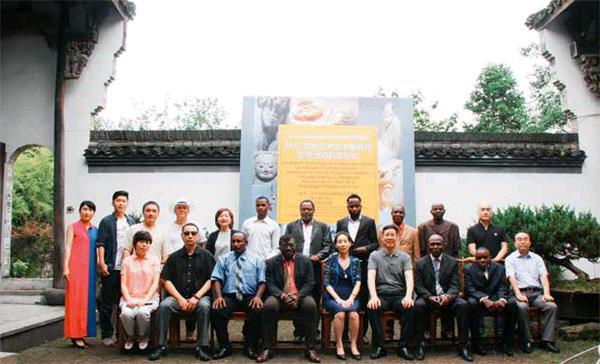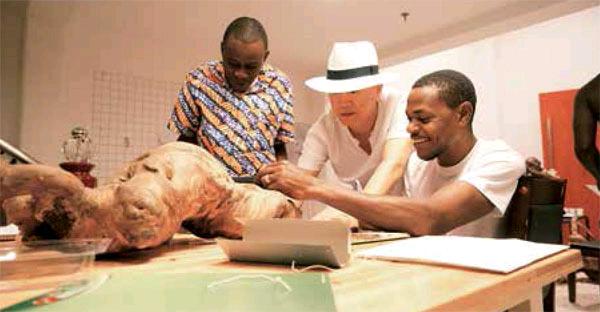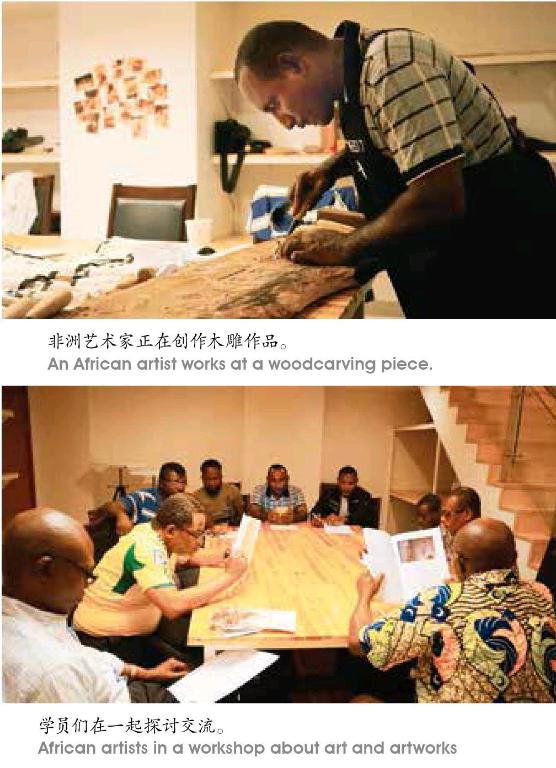中非木雕藝術結緣浙江
栗子+黃蕓
非洲是人類文明的發源地,也是一片神秘而引人遐想的土地。撒哈拉南部大陸閉塞的環境和熱帶高原的氣候孕育了當地獨特的非洲文明。
在輝煌光耀悠久的非洲文化中,非洲木雕藝術以淳樸、稚拙、粗獷和夸張的藝術形象屹立于世界藝苑之中。而浙江木雕同樣馳名天下,樂清黃楊木雕、東陽木雕等國家級非遺傳統技藝聲名遠揚,東陽更是有“中國木雕之鄉”的美譽。中非木雕藝術又將碰撞出怎樣的火花?

有中國韻味的非洲雕塑作品
7月13日,文化部對非文化培訓基地非洲藝術家木雕創作交流活動暨大運河文化主題創作交流結果展在杭開幕。展覽共展出近50件作品,集中展出了來自剛果民主共和國、吉布提共和國、加蓬共和國、中非共和國四國的9位受邀非洲木雕藝術家在浙江近一個月的“培訓結果”。
據悉,此次文化部對非文化培訓基地非洲藝術家木雕創作交流活動于6月23日正式啟幕,所邀請的9名“學員”均是其國內資深的木雕藝術家,有著十幾年甚至幾十年的創作經驗。
本次浙江省對非文化培訓活動意義深遠。
2015年12月5日,中國國家主席習近平出席中非合作論壇,主持通過《中非合作論壇約翰內斯堡峰會宣言》和《中非合作論壇——約翰內斯堡行動計劃(2016—2018)》并作總結發言。《中非合作論壇——約翰內斯堡行動計劃(2016—2018年)》中,提出“要加大對非洲文化領域的人力資源培訓力度。中方將設立十大‘對非洲文化培訓基地,實施對非洲文化培訓‘千人計劃”。為促進中非文化交流,進一步落實《中非合作論壇-約翰內斯堡行動計劃(2016-2018年)》中提出的理念,浙江省文化館作為文化部首批“對非培訓基地”,今年承辦了非洲人士木雕創作交流活動。
事實上,作為文化部首批“對非培訓基地”,浙江省文化館自2011年起,已接連承辦了文化部“博茨瓦納學員刺繡培訓班”、“非洲學員竹編培訓班”、“非洲學員陶藝培訓班”等活動,為中非文化交流與相助拓寬了渠道和內容。
不到一個月的木雕創作交流活動期間,中國美術學院教授、中國美術學院藝術設計職業技術學院院長趙燕,中國美術學院雕塑與公共藝術學院副院長班陵生等人組成專家師資團隊,為非洲藝術家們開設理論課程,并加入配合創作。此外,非洲藝術家們還參觀了浙江博物館,學習了東陽木雕的創作技法。7月16日,來自非洲國家的木雕藝術家9人受邀走進開化縣根宮佛國文化旅游區進行創作交流。交流期間,非洲藝術家們對開化根雕技藝贊不絕口,并走進創作基地學習開化根雕的創作技法,和開化根雕藝術“親密接觸”。
“中國的木雕作品給我留下的最大印象,是其流露出的對生活的熱愛與對寧靜的憧憬。這些感受就像一團火,點燃了我的創作靈感。”來自剛果民主共和國的曼金杜拉·維克多·迪路澤伊如是說。
“本次展覽既體現出人文與自然的對話,也展現出差異國家、差異民族的交流,以及差異文化的碰撞。在不到一個月的時間里,中非藝術家們能夠創作出這么多既有中國韻味,也具有非洲語言的雕塑作品,再一次證明,藝術語言是沒有國界的。”中國美術學院雕塑系教授龍翔評價道。
讓中非文化交流“長流水,不斷線”
作品《天使出現》是剛果民主共和國哈桑的一個作品,作品用樹根的一部分雕刻女人的造型和一個保護神,仔細欣賞作品,也許你能感覺到這樣一個美好的畫面:水緩緩流出,天使出現在你眼前。

哈桑是金沙薩美術學院的一名教師,他完成這個作品主要使用了一種叫做“高速轉”的用于雕刻的小型機械,這是他第一次使用這個電動工具,他說這個工具讓他的工作進展更快,有可能的話他想購置這種工具帶回國。
1968年隨著對象牙雕刻制品需求的增長,在非洲,許多從事木雕行業的藝人轉向象牙雕刻。多年后由于象牙貿易被禁止,大部分雕刻藝人又回到了木雕行業。“我是在班吉那條雕刻街上長大的,從小我就立志要從事雕刻事業,1986年我投身木雕行業,在多家木雕工場學習過,我的運氣很好,認識了許多有豐富經驗的師傅,從他們那里學到許多東西、接受了很好的培訓,他們中的一些人至今仍健在。在這期間我有幸結識了中非造型藝術組織,并參加了一個國際性的造型藝術組織(它的總部在瑞士日內瓦)。”來自中非共和國的托馬斯·博卡告訴我們。
在班吉,他有自己的木雕工作室,每年根據不同季節,會邀請一些本國的或國外的木雕藝術家來工作室搞創作交流,分享彼此的經驗成果和快樂。“我非常滿意我在中國的學習訪問,我的創作水平也得到了提高,我每天都在努力,每天都在進步。我要為祖國的木雕藝術貢獻自己的才智和作品,以回報祖國對我的信任。”
中非共和國的加利利,他的作品《美麗浙江》需要細細欣賞,方能體會作者的意圖。作者用他的作品表達了他對浙江的喜愛,第一眼就被畫境般的山水折服,美麗的西湖和大運河代表了浙江許多自然風光和歷史文化遺產,還有在浙江這片土地上生活著勤勞、勇敢、熱愛和平的人民。加利利出生于藝術家庭,父母都是從事繪畫藝術的,從小就受到繪畫藝術熏陶。他告訴我們這是第一次來中國,總覺得自己像是在做夢,這次來華的體驗,是他人生中一大幸事。
吉布提共和國的哈馬德是一位自學成才的木雕師,他的作品總能給我們帶來歡樂。他的作品取名《歡樂》。在他眼中,他創造的那個村莊擁有著和杭州一樣的美。

《福音》,一件極具非洲異域風情的作品,作者是加蓬共和國的山普利斯。他從7歲起學習木雕技藝,這個作品表現的是通過齊特拉(齊特拉琴是莊嚴的圣職授任儀式中演奏的樂器)的音樂表達虔誠與感恩之心。
此次展覽還有一個亮點,中國與非洲的藝術家以“風雨同舟”為主題,共同創作了一件木雕作品。參與創作的中方藝術家是這近一個月來與非洲藝術家朝夕相處的樸守帆老師,他作為此次活動的主要指導老師和杭州工匠周揚老師一起與非洲藝術家切磋交流,相互學習討教。
“希望非洲木雕藝術家們能將此次交流學習的所觀所感帶回非洲,成為中非文化交流的使者,讓中非雙方的文化交往‘長流水,不斷線。”文化部外聯局非洲處副處長馬云飛表示。中非友誼源遠流長、基礎深厚。600年前鄭和下西洋,促進了中非人民的友好往來。中華人民共和國的成立和非洲國家的獨立,開啟了中非交往的新紀元。雖然相距遙遠,但萬水千山隔不斷中非人民的深厚友誼。通過藝術交流進一步推進中非友誼,也將使友誼之橋更加堅固。
Africa, particularly central Eastern Africa, is widely accepted as the place of origin of humans and great apes, as evidenced by the discovery of the earliest hominids and their ancestors. This mysterious vast land hosts a diversity of ethnicities, cultures and languages, and varies greatly with regard to environments. The occlusive environment and an extremely arid, tropical climate of the Sahara-Arabian desert to the north make the area the seedbed of one of the unique cultures in Africa.
Unique wood cultural sculptures, known for their bold naturalism and ‘boorish aesthetic beauty, constitute an important part in the cultural splendor of Africa. In Chinas woodcarving scene, boxwood craft from Yueqing and woodcarving from Dongyang, both representing the cultural riches of Zhejiang Province, are two of the shining stars. Dongyang, in Jinhua District of Zhejiang, is reputed as Chinas Woodcarving Capital.
July 13, 2017 saw the opening of a cultural exchange exhibition held in Hangzhou. The exhibition displayed about 50 wood carving works by nine African woodcarving artists who had taken part in a month-long program in Hangzhou. Representing Democratic Republic of Congo, the Republic of Djibouti, Gabon, and Central African Republic, all the nine participating artists represented the highest level of African woodcarving art.
The cultural exchange program was launched also to echo President Xi Jinpings speech at the Johannesburg Summit of the Forum on China-Africa Cooperation on December 5, 2015. In the speech, Xi Jinping urged that China-Africa cultural communication be intensified through more vigorous talent training.
Taking the lead in the exploration of China-Africa cultural dialogue, Zhejiang Cultural Center has launched a series of training programs targeting African artists since 2011. During the woodcarving exchange program, participating artists had a taste of the long-standing woodcarving art of China exemplified by craftsmen in Dongyang and Kaihua.
“The fierce passion for life embodied in the craft inspires me,” one of the participating artists said.
“The Hangzhou exhibition shows the interesting chemistry between the Chinese and African cultures. The fact that in such a short period of time the African artists grasped the quintessence of Chinese arts and expressed it through the African art language was a beautiful illustration of the power of art in cross-cultural communication,” Long Xiang, a professor at China Academy of Fine Arts, commented about the significance of the exhibition.
, one of the works by the artist from Democratic Republic of Congo, is a root-carving piece depicting a woman and her guardian angel. A teacher from the Kinshasa Art Institute, the artist was impressed by an electric tool he used for the making of the artwork. “It added a lot to my efficiency and I hope I can find a way to buy one and take it home,” he recalled.
“I was raised on the woodcarving street in Bangui. The immersion in the African woodcarving craft from my childhood and many years of apprenticeship with a multitude of workshops and many experienced teachers prepared me for what I am today as a woodcarving artist. I have been lucky, and learned a lot from a Geneva-headquartered international plastic arts organization,” an artist from Central African Republic shared.
“It was such a happy and rewarding experience for me. I learned a lot from the program in Zhejiang, making progress with each passing day,” he added.
, a piece full of African elements, was crafted by an artist from Gabon. The idea behind the artwork is a musical way of expressing devotion and gratitude through a zither.
A highlight of the exhibits was a wood sculpture jointly crafted by Pu Shoufan, a Chinese artist who was also the superintendent of the program, and the African artists.

